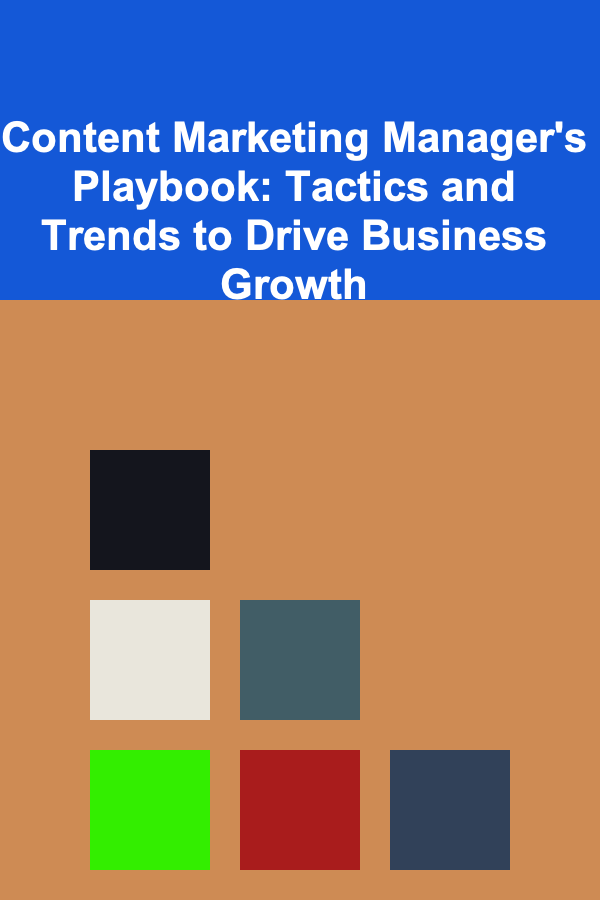
Content Marketing Manager's Playbook: Tactics and Trends to Drive Business Growth
ebook include PDF & Audio bundle (Micro Guide)
$12.99$11.99
Limited Time Offer! Order within the next:

In today's fast-paced digital landscape, the role of a Content Marketing Manager (CMM) has become indispensable to a company's success. Content marketing is no longer just about creating blog posts and sending out newsletters---it's about aligning content with business goals, building meaningful connections with audiences, and leveraging emerging trends and technologies to drive growth.
For businesses looking to scale, content marketing provides a powerful, sustainable way to engage customers, nurture relationships, and convert leads. But to succeed, content marketing managers must stay agile, embracing new tactics and staying ahead of the trends. In this actionable guide, we'll cover the key strategies, tactics, and innovations that CMMs should embrace to drive business growth.
Crafting a Strategic Content Plan
Aligning Content with Business Objectives
A successful content marketing strategy doesn't happen by chance. It starts with a clear understanding of your business objectives and the role content will play in achieving them. Whether your goal is to increase brand awareness, generate leads, improve customer retention, or drive revenue, every piece of content should serve a specific purpose aligned with these goals.
- Set Clear KPIs (Key Performance Indicators): It's crucial to define measurable goals. Whether it's boosting website traffic, increasing social media engagement, or generating qualified leads, knowing your KPIs allows you to assess the effectiveness of your content strategy.
- Audience Segmentation: Understand who you're creating content for. Develop buyer personas that represent different segments of your audience. This will help tailor content to the specific needs, challenges, and behaviors of each group, increasing the likelihood of engagement and conversions.
Mapping Out the Content Journey
The content journey refers to the process of guiding your audience from awareness to decision-making, ultimately leading to conversions. Understanding this journey allows you to create content that nurtures prospects through each stage.
- Top of the Funnel (TOFU): Content here should be educational and informative, introducing potential customers to your brand and establishing trust. Blog posts, infographics, videos, and social media content work well for this stage.
- Middle of the Funnel (MOFU): At this stage, prospects are aware of their challenges and are looking for solutions. Case studies, webinars, and detailed guides can help show how your product or service can address their pain points.
- Bottom of the Funnel (BOFU): This is the final stage where prospects are deciding on a solution. Provide content that pushes them toward making a purchase decision, such as product demos, customer testimonials, and offers.
Optimizing Content Creation and Quality
The Importance of Storytelling
In an overcrowded digital space, it's not enough to simply deliver information. The most effective content tells a compelling story that resonates with the audience. Whether you're discussing product features, customer success stories, or company values, make sure your content evokes emotion, aligns with your audience's needs, and drives action.
- Humanize Your Brand: Personalize your messaging and tone. Show the human side of your business. Use real customer stories, testimonials, and behind-the-scenes glimpses to build trust and connection.
- Focus on Value: While storytelling is important, don't forget to provide value. Whether it's solving a problem, answering a question, or offering useful insights, value-driven content fosters long-term engagement.
Content Formats that Drive Results
Different types of content appeal to different segments of your audience, and diversifying content formats helps you reach a broader spectrum of potential customers. By combining various formats, you can create a more engaging experience that keeps your audience interested.
- Blog Posts and Articles: These remain foundational to content marketing. Focus on providing in-depth, well-researched, and SEO-optimized articles that answer the questions your target audience is asking.
- Video Content: Video consumption is on the rise, with platforms like YouTube, TikTok, and Instagram driving engagement. Create explainer videos, tutorials, product demonstrations, and even live Q&A sessions to engage your audience more personally.
- Infographics: People love visual content. Infographics are an excellent way to present data, simplify complex topics, and make your content shareable on social media.
- Interactive Content: Quizzes, polls, surveys, and calculators are powerful tools to increase user engagement. They provide instant feedback and a sense of interaction that static content can't offer.
Distribution Strategies for Maximum Reach
Multichannel Content Distribution
Even the best content can fall flat if it doesn't reach the right audience. A robust distribution strategy ensures that your content is seen by the right people, in the right place, and at the right time.
- Owned Media: This includes your website, blog, and email newsletters. Owned media provides you with full control over your content, but it's important to ensure that it's optimized for search engines (SEO) and easily shareable.
- Earned Media: Media coverage, guest posts, backlinks, and social media shares fall into this category. While it takes time to build earned media, it can lead to higher authority, greater reach, and more credibility.
- Paid Media: With the decline in organic reach on platforms like Facebook, paid media can help boost content visibility. Consider using sponsored posts, PPC ads, and paid search campaigns to amplify your content.
SEO Optimization
Search engine optimization (SEO) is the cornerstone of content discoverability. No matter how compelling your content is, if it's not optimized for search engines, it's less likely to be found by your target audience.
- Keyword Research: Use tools like Google Keyword Planner, SEMrush, or Ahrefs to identify high-value keywords related to your business. Focus on both short-tail and long-tail keywords to capture a variety of search intents.
- On-Page SEO: Make sure your content is optimized for search engines. This includes optimizing headings, meta descriptions, image alt text, and ensuring proper keyword placement throughout your content.
- Link Building: Both internal and external links improve SEO performance. Link internally to relevant content on your website and aim to get high-quality backlinks from authoritative websites to boost your SEO ranking.
Email Marketing as a Distribution Channel
Email marketing remains one of the most effective ways to distribute content and nurture leads. However, it's essential to use segmentation and personalization to make your email campaigns more effective.
- Segmentation: Divide your email list into different segments based on interests, behavior, or stage in the buyer's journey. Tailoring your content to specific segments increases the likelihood of engagement.
- Personalization: Personalize your emails by using recipient names and offering content that resonates with their individual needs or preferences. Tools like Mailchimp, HubSpot, and ActiveCampaign make it easier to implement advanced segmentation and personalization.
Leveraging Data and Analytics for Continuous Improvement
Measuring Success with Metrics
Content marketing is not just about producing content; it's about measuring the success of that content and optimizing based on the results. Without tracking key metrics, you won't know what's working and what's not.
- Traffic and Engagement: Track metrics like website traffic, bounce rates, and time on page to gauge how well your content is engaging visitors.
- Lead Generation: Monitor conversion rates and lead generation metrics to see if your content is driving actionable results, such as email sign-ups, downloads, or contact form submissions.
- Social Metrics: Measure social media engagement through likes, shares, comments, and click-through rates to assess how your content is performing on social platforms.
- Customer Lifetime Value (CLV): This metric helps you understand how well your content contributes to the long-term success of your customers. Content that nurtures leads and converts them into loyal customers increases CLV.
A/B Testing for Optimization
A/B testing is a powerful technique to continuously optimize your content marketing efforts. Test different headlines, calls-to-action (CTAs), images, and even content formats to determine what resonates best with your audience.
- Test One Element at a Time: When conducting A/B tests, focus on testing one variable at a time (e.g., headline, CTA button color, etc.). This ensures you can isolate the impact of the tested change and gain actionable insights.
- Iterate Based on Results: Use the data from your tests to refine and improve future content. Content marketing is an iterative process, and constant optimization ensures that your strategy remains effective.
Innovations Shaping the Future of Content Marketing
Artificial Intelligence (AI) and Automation
AI is revolutionizing the content marketing industry, enabling content managers to automate repetitive tasks, enhance personalization, and optimize content distribution.
- Content Creation: Tools like GPT-3 (the model behind ChatGPT) are helping marketers automate the process of content generation, freeing up time for more creative tasks.
- Personalization at Scale: AI tools can analyze customer data to deliver highly personalized content at scale. Whether it's email marketing, landing pages, or product recommendations, AI-driven personalization is becoming more sophisticated.
- Chatbots and Conversational Marketing: Chatbots powered by AI are increasingly used for customer service and lead generation. Conversational marketing engages customers in real-time and provides an instant, personalized experience.
Video and Interactive Content
Video content continues to dominate the digital space, and interactive content (quizzes, polls, interactive videos) is gaining ground as well. Both types of content drive deeper engagement and foster stronger relationships with your audience.
- Short-Form Video: Platforms like TikTok and Instagram Stories have made short-form video one of the most engaging formats for marketers. It's perfect for quick, engaging content that's easily shareable.
- Live Streaming and Webinars: Live video allows for real-time interaction, which is excellent for building trust, answering questions, and offering special promotions.
Conclusion
Content marketing is a dynamic and ever-evolving field. As a Content Marketing Manager, staying on top of trends, embracing new technologies, and continually optimizing your strategies will ensure that your business remains competitive in a crowded marketplace. By creating a solid content strategy, focusing on quality content, optimizing distribution, and leveraging data, you can effectively drive growth and create meaningful connections with your audience. Always remember, the key to success in content marketing is adaptability and constant innovation.

How to Create a Workflow Chart to Streamline Tasks
Read More
How to Maintain Your Home's Electrical System for Safety
Read More
How to Organize a Home Office with Effective Furniture Placement
Read More
How to Store Your Kids' Toys in a Way That Saves Space
Read More
How To Grasp the Principles of On-Ramps and Off-Ramps for Crypto
Read More
How To Explore Stablecoins and Their Uses
Read MoreOther Products

How to Create a Workflow Chart to Streamline Tasks
Read More
How to Maintain Your Home's Electrical System for Safety
Read More
How to Organize a Home Office with Effective Furniture Placement
Read More
How to Store Your Kids' Toys in a Way That Saves Space
Read More
How To Grasp the Principles of On-Ramps and Off-Ramps for Crypto
Read More